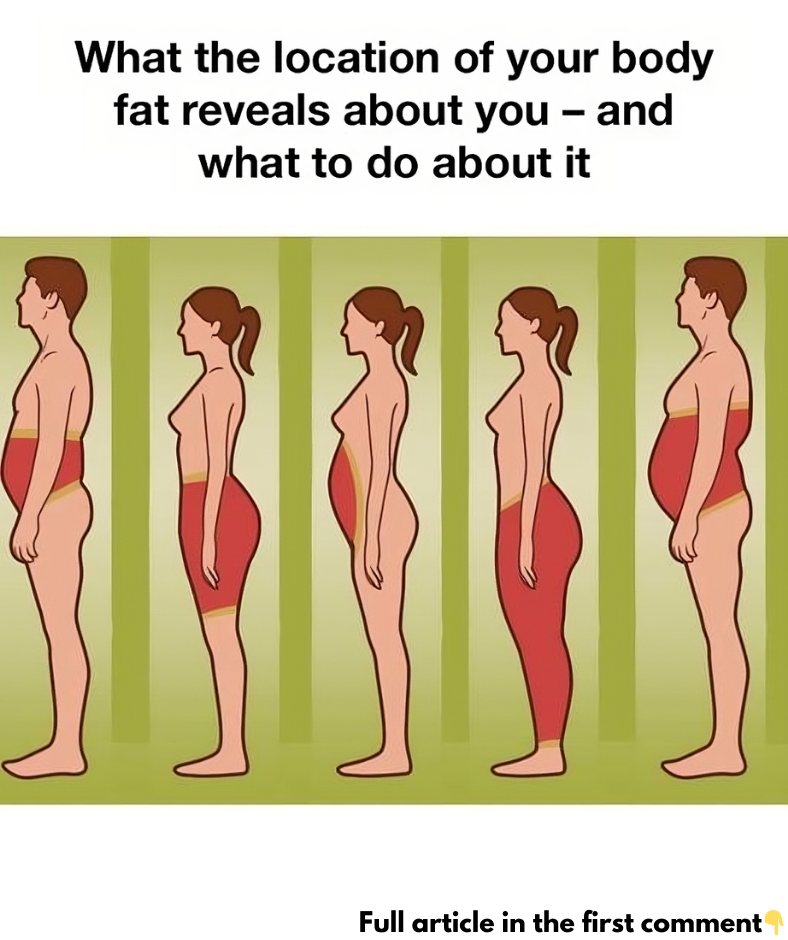Body fat distribution goes beyond aesthetics; it provides important insights into your overall health. Where your body stores fat can signal potential risks for conditions such as heart disease, diabetes, and metabolic disorders. Factors like genetics, hormones, lifestyle, and diet determine fat storage patterns, and understanding where your body accumulates fat can help you create a targeted strategy for improving your health. Let’s explore what your fat location reveals about your health and how to take action.

Why Body Fat Distribution Matters
Fat isn’t just fat. Where it’s stored in your body plays a crucial role in your health. Different types of fat—such as visceral fat, which surrounds your organs, and subcutaneous fat, which sits beneath your skin—impact your body differently. Visceral fat poses higher health risks, while subcutaneous fat is generally less dangerous. Knowing your body’s fat distribution can guide you in making informed lifestyle changes.
Upper Body Fat (Apple Shape)
If you carry most of your fat around your abdomen, chest, and back, you likely have an “apple shape.” This type of fat distribution is associated with visceral fat, which surrounds vital organs in the abdominal cavity. Visceral fat is linked to serious health issues such as insulin resistance, type 2 diabetes, and heart disease.
To reduce upper body fat, focus on:
- Cardiovascular exercises such as running, cycling, or swimming to burn calories and reduce overall fat.
- Strength training to target your core and upper body, helping tone muscles and improve metabolism.
- A balanced diet rich in lean proteins, whole grains, and healthy fats, while reducing sugary and processed foods.
Lower Body Fat (Pear Shape)
If you store fat primarily in your hips, thighs, and buttocks, you have a “pear shape.” While lower body fat is less risky than upper body fat, it can still lead to problems like joint issues or varicose veins due to the extra weight on your legs.
To manage lower body fat:
- Aerobic exercises like walking, running, or cycling to burn fat in the lower body.
- Strength training that targets the legs with exercises such as lunges and squats to tone muscles.
- A diet rich in whole foods, lean proteins, and low-glycemic carbs to support fat loss.
Total Body Fat (Overweight/Obese)
When fat is evenly distributed throughout the body, it can indicate being overweight or obese. This increases the risk of numerous health issues, including high blood pressure, cardiovascular disease, and diabetes.
To reduce overall body fat:
- Calorie control through mindful eating and healthier food choices.
- Consistent physical activity with a combination of cardio and strength training to burn calories and build muscle.
- Support groups or behavioral therapy to address emotional and psychological aspects of weight management.
Visceral Fat: The Most Dangerous Fat
Visceral fat, stored deep within the abdominal cavity, wraps around organs like the liver and pancreas. This type of fat is the most dangerous because it contributes to chronic inflammation, which increases the risk of heart disease, type 2 diabetes, and even certain cancers.
To reduce visceral fat:
- High-intensity interval training (HIIT) is effective for burning visceral fat quickly by elevating your heart rate.
- A low-carb, low-sugar diet helps stabilize insulin levels, which is critical for reducing visceral fat.
- Stress management, such as practicing yoga, meditation, or breathing exercises, helps lower cortisol levels, which contribute to visceral fat storage.
Subcutaneous Fat: The Visible Fat
Subcutaneous fat is the layer of fat you can pinch under your skin. Although it is less dangerous than visceral fat, having too much subcutaneous fat can still contribute to health risks like obesity.
To reduce subcutaneous fat:
- Cardio exercises like biking, running, or swimming to burn fat.
- Strength training to build muscle, which helps increase metabolism and reduce fat.
- A balanced diet with portion control, focusing on nutrient-dense foods and limiting empty calories.
How to Manage Body Fat
Understanding where your body stores fat provides a roadmap for improving your health. Whether you accumulate fat in your upper body, lower body, or throughout, there are steps you can take:
- Exercise regularly with both cardiovascular and strength training activities.
- Eat a balanced diet of whole foods, lean proteins, and healthy fats.
- Stay hydrated, as water supports fat metabolism.
- Get enough sleep, as sleep helps regulate hunger hormones and fat storage.
- Manage stress, as stress can lead to increased fat storage, particularly around the abdomen.
Your body fat location can offer vital clues about your health and the steps you can take to manage it. From the more dangerous visceral fat, which raises your risk of chronic diseases, to subcutaneous fat, which can contribute to obesity, knowing where your fat is stored can help you create a targeted plan for fitness and health. By adopting a healthy lifestyle that includes exercise, a balanced diet, stress management, and proper sleep, you can effectively reduce body fat and improve your overall well-being.





